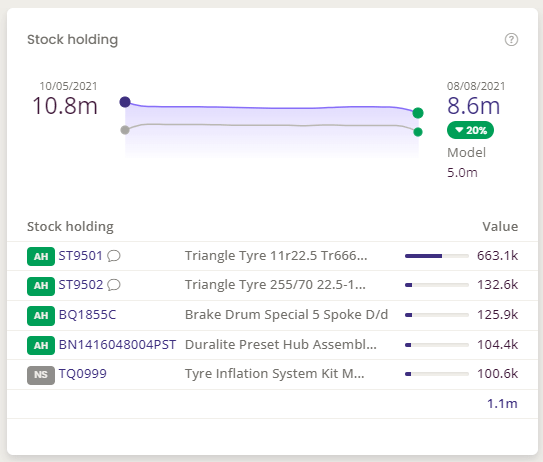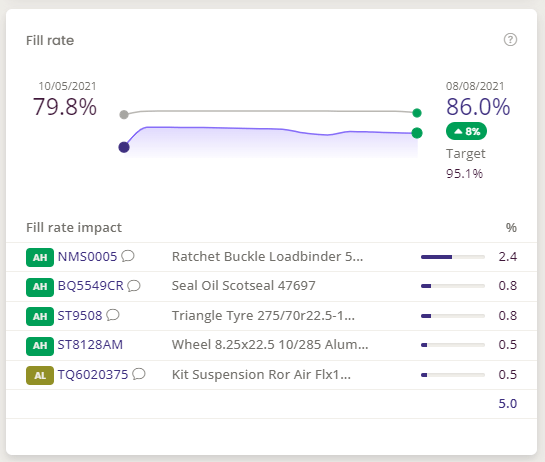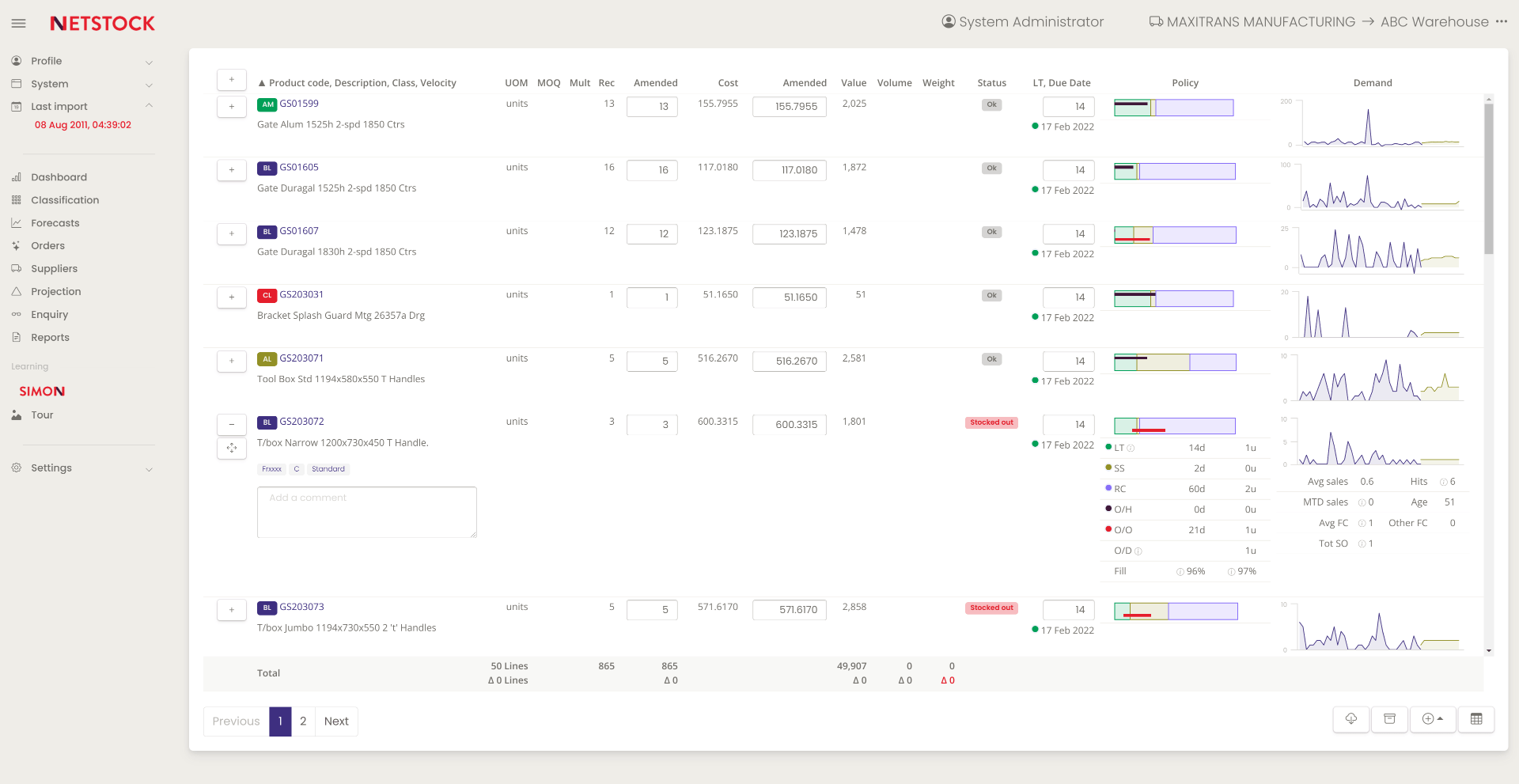Key Performance Indicators (KPI’s) help you monitor and make vital decisions for your inventory.
What are some of the critical inventory management KPI’s for your supply chain, and how do they affect your inventory holding?
As an inventory planner, you’ll know that the supply chain is in flux, and it has become crucial to set the necessary inventory KPI’s to help you make decisions for your business and make sure you serve your customers on time and in full. If you haven’t set these yet, you’re reading the right article!
The more volatile the supply chain becomes, the more regularly you have to establish, review and measure your KPI’s to help organize and plan your inventory accordingly.
Inventory visibility aims to show all internal records of your inventory, and it’s crucial for your supply chain so you can better stock, monitor and order relevant items at the necessary time before potential stock-outs occur. Having complete visibility of your inventory holding is a complicated but necessary process.
Entrepreneur states, “Knowing what’s happening in your supply chain is vital, especially during and after market disruptions like these’85 Having a 360-degree view of the entire supply chain network is of paramount importance. The lack thereof can result in supply chains being disorganized, expensive, and inefficient.”
Keeping the above in mind, supply chain disruptions, like:
- complex customer orders
- a lack of data and insights
- a shortage in shipping containers
- and transportation capacity
can add extra strain to monitoring, tracking, and having complete visibility over your inventory holding. However, if you have the right inventory KPIs in place, your supply chain is well on its way to success.
According to Material Handling & Logistics, “With today’s immense challenges due to the COVID-19 pandemic disrupting and debilitating the traditional retail model, plus the extreme volatility in supply and demand experienced by so many omnichannel organizations, the need for an efficient and agile supply chain has become ever more apparent. A not only resilient, but optimized supply chain is imperative to success, directly impacting sales, customer service, brand loyalty, and competitive advantage.”
You should monitor your inventory KPI’s constantly to make sure your inventory holding is fit-for-purpose.
You’ll need to ask yourself the following questions:
- What is a KPI?
- What inventory KPI’s should I have in place?
- How do I set, refine, and track my inventory KPI’s?
- What are the benefits of setting KPI’s for my inventory?
- What demand planning solution can I implement?
1) What is a KPI?
Before we can start defining inventory KPI’s, we will make a definition upfront.
G2, a business software and services review platform, says, “A key performance indicator (KPI) is a way to evaluate the success of an activity that an organization or department engages in. KPI’s are values that can be measured against desired results. High-level KPI’s are focused on the overall performance of an entire business, while low-level KPI’s focus on the performance of individual departments within that business.”
You need to remember that your business has KPI’s for production, processes, cash flow, and profitability, which ultimately measure your business operations’ impact. The business goals and objectives will influence your inventory policies. The inventory KPI’s are then used to monitor the inventory policies, track inventory turnover and ultimately measure how well your inventory performs based on your sales.
2) What inventory KPI’s should I have in place?
You can’t manage what you don’t measure, and you’re flying blind if you don’t measure what you do in your inventory or business. Your KPI’s are like your North Star, and they affect the overall performance and visibility of your inventory holding.
As Multichannel Merchant notes, “Today’s shopper wants visibility into the entire order fulfillment process , from accurate availability at purchase to tracking information during shipment. Fulfillment visibility is no longer a nice-to-have but a must-to-compete in ecommerce and improve your bottom line.”
At Netstock, we divide inventory KPI’s into two parts, namely:
1) Stock holding: The amount of inventory a company keeps for future use compared to an ideal model.
- What is your inventory value compared to the benchmark in your industry?
- Where are you in excess?
- Where are you ordering too much of an item which results in excess stock?
2) Fill rate: The percentage of demand met by immediate stock availability. Track how well you’re servicing your existing customer base compared to what you’re targeting.
- Measuring the fill rate and how well you serve your customers.
- When and where do stock-outs occur?
- Where will you potentially stock out, and when will you run out of stock in the future?
- Where are you forecasting too much or too little? If you forecast too much, you’ll have excess stock. If you don’t forecast enough, potential stock-outs will occur.
[Images] Stock holding and Fill rate
3) How do I set, refine and track my inventory KPI’s?
When you start looking at your inventory, you need to know the value of your inventory holding in your business relative to how much excess stock you have.
Is the value of your inventory holding increasing or decreasing? It’s vital to:
- Classify your items by looking at each item’s value and velocity.
- If you measure your inventory value, you need to compare it to previous periods respectively.
Understand your fill rate targets and track towards them. If you keep getting closer to the target, you know you are going in the right direction. Keep tracking it. You have to know what you want to measure, your target, and how it’s changing over time.
In a more stable environment, you can review your KPI’s less frequently. When reviewing, ensure that you examine your upstream supply and downstream demand. Frequently review your orders and see if they align with your demand and whether your ordering cycle correlates with the current reality of receiving stock from your suppliers. We recommend reviewing the highest value and the fastest moving spend more closely to get the best value for your spend.
4.) What are the benefits of setting KPI’s for my inventory?
The use and selection of inventory KPI’s help evaluate operational processes and turn them into financial records.
Selecthub believes, “The purpose of using metrics and KPI’s across inventory control systems is to drive the most effective behaviors, decisions and strategies possible. Metrics and KPI’s that reinforce the silo-based behavior of many manufacturers (such as data and knowledge hoarding) are being replaced by those that reward collaboration. With valuable metrics and increased collaboration, businesses are able to improve on-time deliveries, increase customer satisfaction and reduce operating costs.”
If you don’t have a demand planning solution and KPI’s in place, your inventory value will be inaccurate, and you will experience potential stock-outs with longer lead times, and customers will be unhappy and leave. If you don’t know what will happen in the future, you can’t plan for today and make sure your business will go where you want it to be.
5.) What demand planning solution can I implement?
The Netstock Inventory Dashboard allows you to effectively manage what you measure well in your inventory, namely stock holding and fill rate. Focus your attention on the top 5 items that will help you positively impact your inventory.
The key is to work on the 80/20 principle – focus on 20% of the stock items, which will give you 80% of the sales and help you make a massive and intelligent impact on getting your inventory on the right path.
RAM Products, established over 30 years ago, is a privately-owned Maintenance Repair and Operations (MRO) business. The company supplies parts to B2B businesses across the USA and they are a prime example of how using Netstock helps them achieve overall inventory visibility. They trust the data and deliver excellent customer service and support.
Using Netstock, we merely change our fill rate percentages and reduce those by around 20% per classification. By adhering to the Netstock order recommendations, we saw our inventory come down. – James Shotts, VP of Operations.
Discover more about RAM Products inventory journey here
If you’d like to identify and define what’s important for your business, learn more about optimizing your supply chain.
Want to learn more about the status of your inventory?








